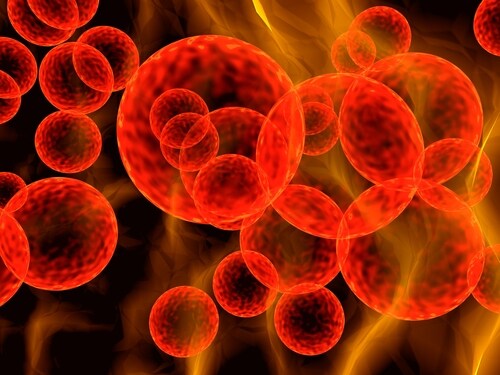 Liquid biopsy is becoming a popular item on clinicians’ current wish lists, with the technique showing great potential for diagnostic and prognostic evaluations. Unfortunately, rare cells such as circulating tumor cells (CTCs) or stem cells that are the target of such biopsies circulate in such low abundance that detecting them is extremely difficult without extensive sample preparation. Li et al. (2015) have published a scaled-down, optimized single-tube sample preparation workflow that produced good results for characterizing the proteome of these rare cells in whole blood.
Liquid biopsy is becoming a popular item on clinicians’ current wish lists, with the technique showing great potential for diagnostic and prognostic evaluations. Unfortunately, rare cells such as circulating tumor cells (CTCs) or stem cells that are the target of such biopsies circulate in such low abundance that detecting them is extremely difficult without extensive sample preparation. Li et al. (2015) have published a scaled-down, optimized single-tube sample preparation workflow that produced good results for characterizing the proteome of these rare cells in whole blood.
Using blood collected from healthy volunteers, Li et al. spiked tumor cell line MCF-7 (human breast cancer cells) at various abundances to mimic reported values for CTCs previously established by other researchers. They used this starting material to optimize a workflow that could maximize proteomic yields with efficiency and accuracy down to the zeptomolar sensitivity expected.
The team initially examined the validity of the experimental workflow using cell lysates corresponding to CTC numbers predicted in clinical samples, processing samples identically to the spiked whole blood preparations by lysing and then digesting cells using trypsin.
Using the MCF-7 cells, Li et al. obtained highly reproducible peptide and protein identifications that varied according to the initial tumor cell abundance. For example, the team identified 5,183 proteins and 41,020 peptides in five runs analyzing 500 MCF-7 cells, as compared to only 1,327±143 proteins from 50 cells. Compared to traditional methods, a porous layer open tubular (PLOT) nano-liquid chromatography (nLC)-based workflow showed increased performance. The team further refined the workflow by using Adaptive Focused Acoustics (AFA) assisted cell lysis, enabling single-tube sample preparation for optimal analyte recovery.
The next step in the workflow involved preferential concentration and immunoaffinity purification to separate the MCF-7 cells from other blood constituents. The researchers prepared magnetic microbeads primed with an antibody, anti-EpCAM, specific to MCF-7 cell surface proteins. Following incubation, the research team collected the target cells using microfluidics and then processed them for onward proteomic analysis. They first lysed the cells and then digested them with trypsin before examining the digests using PLOT-nLC coupled with a Q Exactive hybrid quadrupole-Orbitrap mass spectrometer (Thermo Scientific). The team also added stable isotope labeled peptides to samples after trypsin digestion for targeted quantitative analyses.
Following optimization of microfluidic capture and proteomic assessment of MCF-7 spiked into whole blood using the AFA-PLOT-nLC workflow established in the pure cell lysates, the researchers obtained good purity of isolation, as evidenced by proteomic data comparable with results from pure MCF-7 preparations. The team estimated that only 3% of proteins identified post-separation came from blood constituents other than the MCF-7 cells. In an analysis of approximately 500 MCF-7 cells, the team identified 3,126±103 proteins on average, with 5,117 protein groups identified over four experimental runs. This compared well with results obtained from an equivalent number of pure MCF-7 cells in DPBS (3,449±204 and 5,223 identities, respectively). Further validation carried out using gene ontology (GO) enrichment analysis showed a high degree of similarity for proteomes obtained from the enriched cells and those analyzed in DPBS solution.
As a final exploration of the workflow, Li et al. turned to characterizing the proteomic profiles of rare hematopoietic stem cell (HSC) and endothelial progenitor cell (EPC) populations in whole blood. These two CD133+ cells comprise less than 1% of the total blood cell population and show potential for future clinical application.
Using magnetic beads to enrich samples taken from healthy volunteers, the researchers conducted deep proteome profiling to characterize the two populations. They confirmed specificity by immunoblotting the enriched isolates prior to conducting the proteomic analysis using the established workflow. Furthermore, proteomic analysis also identified proteins specific to HSCs and EPCs, with differential abundances noted for two smokers among the volunteers—results consistent with reported findings in other studies.
The authors note that once optimized and validated, the preparation and subsequent mass spectrometric profiling achieved more than adequate results from smaller sample volumes that effectively characterized low abundances of rare cells in circulation. They believe that this workflow shows the potential for use in individual prognostic testing within clinical settings.
Reference
1. Li, S., et al. (2015, March) “An integrated platform for isolation, processing and mass spectrometry-based proteomic profiling of rare cells in whole blood,” Molecular and Cellular Proteomics, 14 (pp. 1672–83), doi: 10.1074/mcp.M114.045724.
Post Author: Amanda Maxwell. Mixed media artist; blogger and social media communicator; clinical scientist and writer.
A digital space explorer, engaging readers by translating complex theories and subjects creatively into everyday language.
Leave a Reply